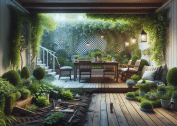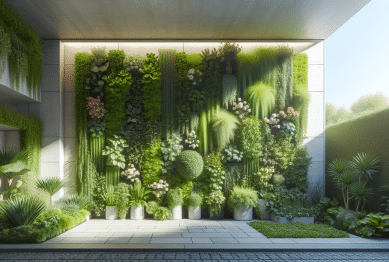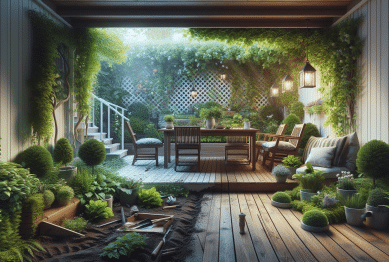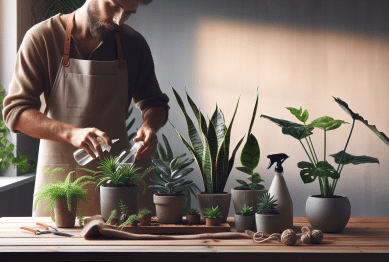Curious about making your tiny outdoor space more inviting? Discover creative strategies for transforming a small backyard on a budget. This guide explores affordable landscaping, functional garden layouts, sustainable plant choices, and tips to maximize every inch of your garden oasis.
Creative Low-Cost Landscaping for Any Backyard
Not everyone has space for sprawling lawns or expensive water features. But landscaping a small backyard can be both accessible and affordable, especially when focusing on budget-friendly options. Simple DIY landscaping, like using mulch paths or reclaimed stepping stones, instantly refreshes an outdoor space. These choices bring structure, define zones, and reduce lawn maintenance costs. Small garden beds along the patio or fence line make the backyard visually larger, especially when paired with subtle edging materials.
Accessible landscaping materials can include gravel, wood chips, and even reused bricks or stones. Local garden centers often offer end-of-season discounts, making it cost-effective to stock up. Planning is key: sketch your space and identify where sunny, shaded, and damp areas are. Matching plants and features to these microclimates boosts the likelihood of a thriving, resilient garden. A clear plan prevents buying unnecessary materials or plants, stretching every dollar while achieving impressive results.
When it comes to maximizing a small backyard, layers matter. Vertical gardens, raised beds, and trellises add visual interest and utilize unused vertical space. Planting in levels with tall grasses, mid-height flowers, and ground covers creates depth and texture on a budget. Many homeowners discover that well-placed containers or a vertical herb wall offer flexibility and vibrancy, especially if the yard is paved or largely hardscaped. Thoughtful placement of each element adds flow to small spaces and helps them feel more expansive.
Smart Plant Selection for Tiny Outdoor Spaces
Choosing the right plants is vital for budget-conscious backyard design. Low-maintenance, drought-resistant species can save significant costs over time. Succulents, ornamental grasses, and native perennials usually require less water and fertilizer, making them practical for small garden layouts. These plants can withstand fluctuating weather and don’t need to be replaced frequently, which helps stretch your landscaping budget further.
Container gardening offers another avenue for flexible and affordable planting. Select pots made from reused materials or look for deals at local markets. Herbs, leafy greens, and compact vegetables thrive in containers, providing fresh produce and ornamental value. Mixing flowering annuals with practical herbs in the same planter maximizes both beauty and function, while allowing easy rearrangement based on sun and shade requirements.
Consider vertical gardens as a dynamic way to green up fences, walls, or the side of a shed. Wall-mounted pockets, pallet planters, and climbing vines make use of vertical space while keeping the ground clear for seating or play areas. Vertical solutions are excellent for renters or those with limited ground-level garden space, and many systems are inexpensive or even homemade. Plant selection—like nasturtiums, strawberries, or creeping thyme—provides visual impact and ease of maintenance all season long.
Maximizing Function and Flow in Small Yard Layouts
Smart layout is crucial when every foot counts. Zoning the backyard into functional areas—such as a dining nook, a play area, or a casual reading corner—makes it possible to enjoy multiple activities in a small space. Simple dividers, like a row of potted plants or a low trellis, can subtly mark boundaries. Thoughtful organization prevents clutter, helps manage foot traffic, and lets the area feel larger than it is.
Multipurpose features add practicality without excess cost. Consider benches that double as storage, foldable tables for impromptu gatherings, or a hammock that can be relocated as needed. Using removable or dual-purpose furniture enables flexibility as seasons and needs change. Careful placement of these elements ensures the backyard is adaptable for family gatherings, solo relaxation, or gardening projects—each without overcrowding.
Paths made from gravel or stepping stones can connect zones elegantly and affordably. These paths provide clear navigation and help prevent lawn wear. Grouping plants with similar water needs allows for easier irrigation management and maintenance. Leaving room for some open ground—whether lush lawn or minimalist gravel—gives the eyes somewhere to rest and ensures the space never feels overly packed.
Affordable DIY Backyard Features That Impress
Simple DIY features often make a surprising impact in small yards. Raised beds from reclaimed timber, homemade birdbaths, or painted planters introduce charm and function at minimal cost. Projects like a vertical pallet planter or a pebble mosaic stepping stone add personality and customization, while recycling materials from around the home keeps expenses low. Many common household items can be upcycled into clever garden décor with a little imagination.
Lighting plays an essential role in extending the use of the backyard into the evening. Solar-powered string lights, lanterns, or LED path markers light up pathways and sitting areas efficiently and inexpensively. Installing lighting yourself is typically straightforward—no need for advanced wiring or extensive labor. Even battery-operated or rechargeable fixtures can transform a backyard’s atmosphere at a fraction of the cost of permanent electrical work.
Water features are desirable but often assumed to be expensive. However, compact wildlife ponds, container fountains, or bubbling urns are accessible DIY projects. They bring soothing sounds and attract birds or beneficial insects. With a little research and the right container or liner, anyone can craft a small water element to suit their space. These touches create focal points and enhance the sense of tranquility in a city garden or compact suburban yard.
Sustainable Gardening Tips for Lasting Results
Sustainable gardening aligns cost savings with environmental responsibility. Composting kitchen and garden waste enriches the soil naturally, reducing dependency on commercial fertilizers. Simple compost bins can be built from recycled pallets or repurposed bins, and kitchen scraps combined with grass clippings help feed flowerbeds throughout the season. This minimizes landfill waste and keeps the garden cycle self-sustaining.
Collecting rainwater is another sustainable practice benefiting small backyard gardens. Rain barrels under downspouts provide an ongoing supply of soft water for plants. It’s both money-saving and eco-friendly, especially in regions with water restrictions. Watering early or late in the day, together with mulching, reduces evaporation and supports plants through summer’s hottest periods. Using native or adaptive species also means less reliance on irrigation, as these plants thrive with the available rainfall.
Encouraging pollinators, like bees and butterflies, brings balance to any backyard habitat. Planting native wildflowers, providing water saucers, and letting a small part of the yard grow a little wild attract beneficial insects. This support for garden biodiversity translates to healthier plants and improved productivity for fruits and vegetables. Overall, sustainable approaches ensure that backyard transformations deliver long-term rewards, both for people and for local wildlife.
Making the Most of Outdoor Living
Outdoor living is about more than plants—it’s about experiencing your backyard every day. Even limited spaces can offer comfort with strategic seating, shade structures, or weatherproof cushions. Prioritizing how the space will be used ensures that every design choice supports your lifestyle, whether for quiet morning coffee or entertaining friends. Adding shade with budget-friendly options, like a fabric sail or a DIY pergola, makes the area comfortable year-round.
Privacy matters when the backyard is small and neighboring properties are close. Solutions such as lattice screens, bamboo fencing, or tall ornamental grasses create a secluded retreat without enclosing the space completely. These elements also bring texture and greenery to the yard, further blurring the line between indoors and outdoors. Personal touches—like colorful throw pillows or a fire pit made from bricks—enhance coziness and invite regular use.
Consistent care keeps a small backyard thriving. A little weeding, regular watering, and tidying up fallen leaves ensure lasting beauty. Simple routines like deadheading flowers or topping up mulch take minutes but pay off by keeping everything growing well. In a small space, attention to detail stands out. Commitment to upkeep helps all the hard work and creativity invested show through, delighting guests and homeowners alike.
References
1. National Gardening Association. (n.d.). Small Space Gardening. Retrieved from https://garden.org/learn/articles/view/3891/
2. University of Minnesota Extension. (n.d.). Landscaping on a Budget. Retrieved from https://extension.umn.edu/garden-design/landscaping-budget
3. EPA. (n.d.). WaterSense: Outdoor Water Use in the United States. Retrieved from https://www.epa.gov/watersense/outdoor-water-use
4. Royal Horticultural Society. (n.d.). Container Gardening. Retrieved from https://www.rhs.org.uk/advice/profile?pid=87
5. Cornell Cooperative Extension. (n.d.). Composting Basics. Retrieved from http://ccetompkins.org/resources/compost-basics
6. Pollinator Partnership. (n.d.). Planting for Pollinators. Retrieved from https://pollinator.org/learning-center









